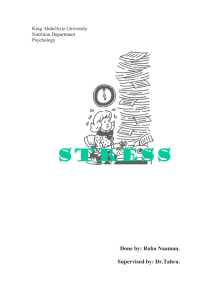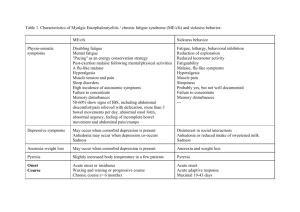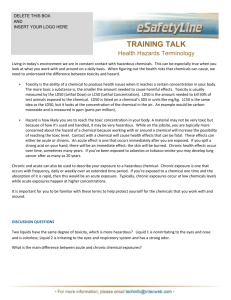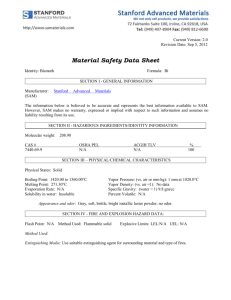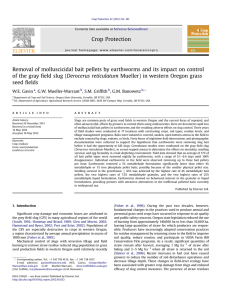Q USDA D -G
advertisement
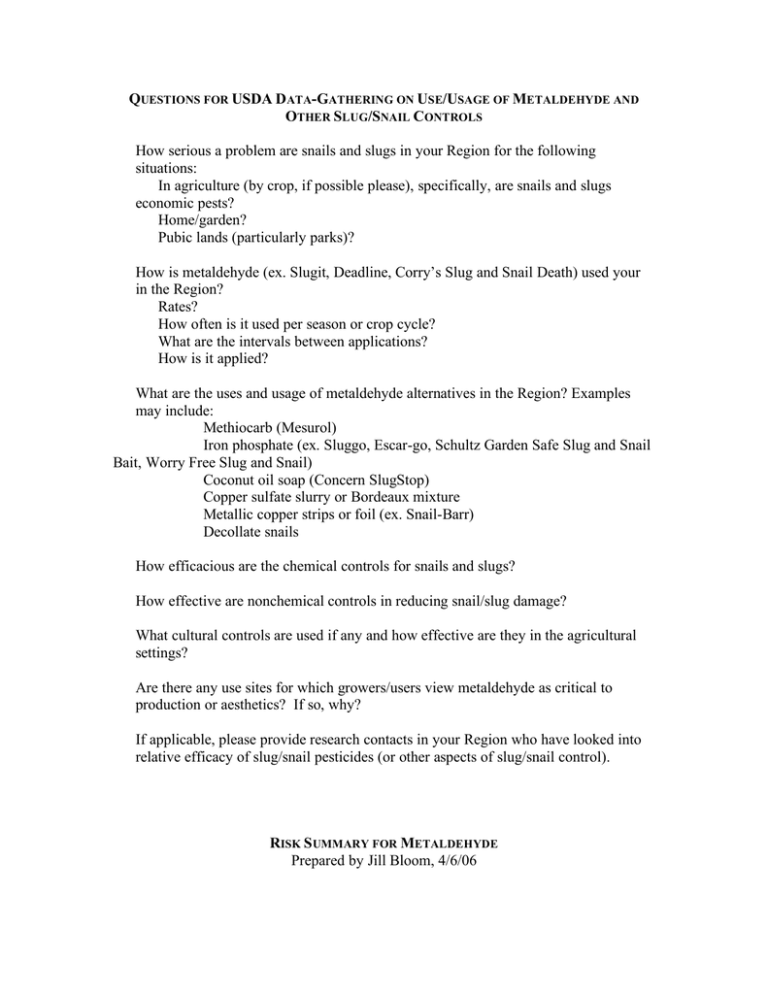
QUESTIONS FOR USDA DATA-GATHERING ON USE/USAGE OF METALDEHYDE AND OTHER SLUG/SNAIL CONTROLS How serious a problem are snails and slugs in your Region for the following situations: In agriculture (by crop, if possible please), specifically, are snails and slugs economic pests? Home/garden? Pubic lands (particularly parks)? How is metaldehyde (ex. Slugit, Deadline, Corry’s Slug and Snail Death) used your in the Region? Rates? How often is it used per season or crop cycle? What are the intervals between applications? How is it applied? What are the uses and usage of metaldehyde alternatives in the Region? Examples may include: Methiocarb (Mesurol) Iron phosphate (ex. Sluggo, Escar-go, Schultz Garden Safe Slug and Snail Bait, Worry Free Slug and Snail) Coconut oil soap (Concern SlugStop) Copper sulfate slurry or Bordeaux mixture Metallic copper strips or foil (ex. Snail-Barr) Decollate snails How efficacious are the chemical controls for snails and slugs? How effective are nonchemical controls in reducing snail/slug damage? What cultural controls are used if any and how effective are they in the agricultural settings? Are there any use sites for which growers/users view metaldehyde as critical to production or aesthetics? If so, why? If applicable, please provide research contacts in your Region who have looked into relative efficacy of slug/snail pesticides (or other aspects of slug/snail control). RISK SUMMARY FOR METALDEHYDE Prepared by Jill Bloom, 4/6/06 No conventional dietary exposures result in risks of concern. No residential handler or post-application risks of concern have been identified. No worker risks of concern have been identified. Domestic animals (usually dogs) can be attracted to and ingest metaldehyde granules; poisoning typically results in death. Formulators now incorporate a bittering agent in home/garden products, but empirical evidence of its effectiveness in preventing domestic animal incidents is lacking and poisoning data are not conclusive. Ecological risks of concern have been identified. Risks to wildlife are calculated as Risk Quotients (RQs), and compared to Levels of Concern (LOCs) for acute, chronic, and endangered species risks. RQs above these LOCs represent risks of concern. For metaldehyde, there are no toxicity data on which to estimate: chronic risks to freshwater invertebrates acute and chronic risks to estuarine/marine fish, acute and chronic risks to estuarine/marine invertebrates, risks to aquatic plants (for plants in general, risk is expected to be low), risk to freshwater and estuarine/marine mollusks (because metaldehyde is a mollusicide, these risks are likely to exceed LOCs) Acute risks to freshwater fish do not exceed the LOC. Acute risks to freshwater invertebrates were not estimated as metaldehdye was practically non-toxic in a submitted study on Daphnia. Acute risks to birds exceed levels of concern for one or more food sources, and one or more sizes of bird, in all use sites: RQs range from 0.02-13.3 (compared to the LOCs for acute risk at 0.5 and for acute endangered species risk at 0.1). The highest risks are associated with smaller birds, watercress, grass grown for seed, and ornamentals. Acute risks to mammals exceed levels of concern for one or more food sources, and one or more sizes of mammal, in all use sites: RQs range from 0.03-2.89 (compared to the LOCs for acute risk at 0.5 and for acute endangered species risk at 0.1). As above, the highest risks are associated with smaller animals, watercress, grass grown for seed, and ornamentals. Chronic risks to birds exceed levels of concern for most food sources in watercress: RQs range from >0.5->18.1 (compared to the LOC for chronic risk at 1). Chronic risks to mammals exceed levels of concern for most food sources, and for all sizes of mammal, in watercress: RQs range from 0.06-5.9 (compared to the LOC for chronic risk at 1). Chronic avian and mammalian risks were not assessed for granular applications (other use sites), but are expected to be high.



